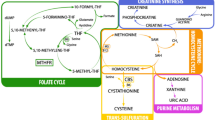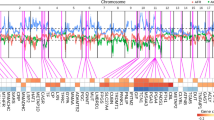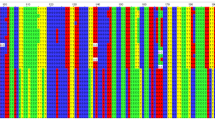Abstract
Homocysteine levels are elevated in mothers of neural tube defect (NTD) children, which may be due to a disturbed folate or vitamin B12 metabolism. Vitamin B12 is transported to the tissues by transcobalamin (TC). We previously showed that a low holo-TC/total-TC ratio is a risk factor for NTD, possibly due to an impaired binding of vitamin B12 to TC. The coding region of the TC gene of 12 individuals was analysed for genetic variations responsible for a disturbed vitamin B12 binding. The influence of the genetic variations observed on total-TC, holo-TC, holo-TC/total-TC, erythrocyte vitamin B12, plasma homocysteine concentrations and risk for NTD was explored in 42 mothers of a child with NTD and in 73 female controls. Direct sequencing analyses revealed five single nucleotide polymorphisms (SNPs). Three SNPs affected total-TC concentrations, whereas two SNPs seem to affect the binding of vitamin B12. None of the genotypes defined by the SNPs had a significant effect on homocysteine levels, or was associated with an increased NTD risk. Among the five SNPs observed only P259R could partly explain the reduced proportion of vitamin B12 bound to TC, which has been associated with an increased risk for having a child with NTD. Some of the variants studied affected total-TC and holo-TC/total-TC ratio but a larger study population is required to elucidate whether these SNPs influence delivery of vitamin B12 to the tissue, influence homocysteine levels and whether they are associated with an increased NTD risk.
Similar content being viewed by others
Log in or create a free account to read this content
Gain free access to this article, as well as selected content from this journal and more on nature.com
or
References
Czeizel AE, Dudas I . Prevention of the first occurrence of neural-tube defects by periconceptional vitamin supplementation N Engl J Med 1992 327: 1832–1835
Anonymous. Prevention of neural tube defects: results of the Medical Research Council Vitamin Study MRC Vitamin Study Research Group Lancet 1991 338: 131–137
van der Put NM, Steegers-Theunissen RP, Frosst P et al. Mutated methylenetetrahydrofolate reductase as a risk factor for spina bifida Lancet 1995 346: 1070–1071
Steegers-Theunissen RP, Boers GH, Trijbels FJ et al. Maternal hyperhomocysteinemia: a risk factor for neural-tube defects? Metabolism 1994 43: 1475–1480
van der Put NM, Thomas CM, Eskes TK et al. Altered folate and vitamin B12 metabolism in families with spina bifida offspring QJM 1997 90: 505–510
Mills JL, McPartlin JM, Kirke PN et al. Homocysteine metabolism in pregnancies complicated by neural-tube defects Lancet 1995 345: 149–151
Mills JL, Tuomilehto J, Yu KF et al. Maternal vitamin levels during pregnancies producing infants with neural tube defects J Pediatr 1992 120: 863–871
Kirke PN, Molloy AM, Daly LE, Burke H, Weir DG, Scott JM . Maternal plasma folate and vitamin B12 are independent risk factors for neural tube defects QJM 1993 86: 703–708
Steegers-Theunissen RP, Boers GH, Blom HJ et al. Neural tube defects and elevated homocysteine levels in amniotic fluid Am J Obstet Gynecol 1995 172: 1436–1441
Steen MT, Boddie AM, Fisher AJ et al. Neural-tube defects are associated with low concentrations of cobalamin (vitamin B12) in amniotic fluid Prenat Diagn 1998 18: 545–555
Afman LA, van der Put NM, Thomas CM, Trijbels JM, Blom HJ . Reduced vitamin B12 binding by transcobalamin II increases the risk of neural tube defects QJM 2001 94: 159–166
Benhayoun S, Adjalla C, Nicolas JP, Gueant JL, Lambert D . Method for the direct specific measurement of vitamin B12 bound to transcobalamin II in plasma Acta Haematol 1993 89: 195–199
Nielsen C, Odgaard G . FK 383 DS, a new silica gel for the determination of unsaturated haptocorrin and transcobalamin II in serum Scand J Clin Lab Invest 1992 52: 767–769
Te Poele-Pothoff M, van den Berg M, Franken DG et al. Three different methods for the determination of total homocysteine in plasma Ann Clin Biochem 1995 32: 218–220
Li N, Seetharam S, Seetharam B . Genomic structure of human transcobalamin II: comparison to human intrinsic factor and transcobalamin I Biochem Biophys Res Commun 1995 208: 756–764
Frosst P, Blom HJ, Milos R et al. A candidate genetic risk factor for vascular disease: a common mutation in methylenetetrahydrofolate reductase Nat Genet 1995 10: 111–113
Chou PY, Fasman GD . Conformational parameters for amino acids in helical, beta-sheet, and random coil regions calculated from proteins Biochemistry 1974 13: 211–222
Garnier J, Osguthorpe DJ, Robson B . Analysis of the accuracy and implications of simple methods for predicting the secondary structure of globular proteins J Mol Biol 1978 120: 97–120
Li N, Sood GK, Seetharam S, Seetharam B . Polymorphism of human transcobalamin II: substitution of proline and/or glutamine residues by arginine Biochim Biophys Acta 1994 1219: 515–520
Li N, Seetharam S, Lindemans J, Alpers DH, Arwert F, Seetharam B . Isolation and sequence analysis of variant forms of human transcobalamin II Biochim Biophys Acta 1993 1172: 21–30
Namour F, Olivier J, Abdelmouttaleb I et al. Transcobalamin codon 259 polymorphism in HT-29 and Caco-2 cells and in Caucasians: relation to transcobalamin and homocysteine concentration in blood Blood 2001 97: 1092–1098
Acknowledgements
We gratefully acknowledge the support of LAJ Kluijtmans and D van Oppenraaij-Emmerzaal. This study was supported by grant no. 00–108 from the Prinses Beatrix Fonds, The Netherlands and by grant no. D97.021 of the Netherlands Heart Foundation
Author information
Authors and Affiliations
Corresponding author
Rights and permissions
About this article
Cite this article
Afman, L., Lievers, K., van der Put, N. et al. Single nucleotide polymorphisms in the transcobalamin gene: relationship with transcobalamin concentrations and risk for neural tube defects. Eur J Hum Genet 10, 433–438 (2002). https://doi.org/10.1038/sj.ejhg.5200830
Received:
Revised:
Accepted:
Published:
Issue date:
DOI: https://doi.org/10.1038/sj.ejhg.5200830
Keywords
This article is cited by
-
Identification of transcobalamin deficiency with two novel mutations in the TCN2 gene in a Chinese girl with abnormal immunity: a case report
BMC Pediatrics (2020)
-
Association of ulcerative colitis with transcobalamin II gene polymorphisms and serum homocysteine, vitamin B12, and folate levels in Chinese patients
Immunogenetics (2017)
-
Concept mapping One-Carbon Metabolism to model future ontologies for nutrient–gene–phenotype interactions
Genes & Nutrition (2014)
-
MTHFD1 G1958A, BHMT G742A, TC2 C776G and TC2 A67G polymorphisms and head and neck squamous cell carcinoma risk
Molecular Biology Reports (2012)
-
The transcobalamin (TCN2) 776C>G polymorphism affects homocysteine concentrations among subjects with low vitamin B12 status
European Journal of Clinical Nutrition (2010)



